Search Engine Positioning - Everything to know in 2023

Imagine you’re a treasure hunter, armed with a magical map that leads to a trove of valuable information. This map is called the “Internet,” and within its vast terrain lies hidden gems of wisdom, insight, and knowledge.
But with millions of treasure chests scattered across this landscape, how do you find the one that holds the exact prize you’re seeking?
That’s where search engine positioning comes in.
You see, there’s a wise and powerful oracle known as the “Search Engine.”
Its primary purpose is to guide seekers like you on their quest for information. The oracle ranks and positions these treasure chests – or websites – based on their relevance, trustworthiness, and popularity. The higher a website’s position in the oracle’s list, the more likely it is to contain the answers you seek.
What is search engine positioning?
Search engine positioning, a critical component of digital marketing and search engine optimization (SEO), refers to the strategic process of improving a website’s visibility and ranking on search engine results pages (SERPs).
Higher positioning on SERPs often leads to increased organic traffic, enhanced brand awareness, and ultimately, a stronger online presence.
The success of search engine positioning hinges upon an intricate interplay of various factors, including keyword research, on-page optimization, off-page optimization, technical SEO, and user experience.
SEO Vs Search Engine Positioning
SEO, or Search Engine Optimization, and Search Engine Positioning are two interrelated concepts that play a critical role in the digital marketing landscape.
Both of these practices aim to improve a website’s visibility on search engine results pages (SERPs), ultimately driving more organic traffic to the site.
| Aspect | SEO | Search Engine Positioning |
|---|---|---|
| Focous | Technique & best practices | Overall stratgey |
| Key components | Keyword research, content creation, website architecture, backlink building | Competitive analysis, target audience identification, continuous monitoring and adjustment |
| Objective | Increase site visibility and credibility | Gain a competitive edge in SERPs |
| Realtionship | SEO is a collection of best practices and tactics used to improve search engine rankings | Search Engine Positioning guides the overall SEO strategy to achieve the desired results |
| Analytics & Reporting | GA 4, GSC | Setting up key performance indicators (KPIs), adjusting strategy based on data insights |
| Timeframe & Consistency | Ongoing process | Long-term strategy with continuous evaluation |
| ROI | Improved organic traffic | Higher search engine rankings |
SEO is the practice of optimizing a website’s content, structure, and user experience to rank higher in search engine results for specific keywords or phrases. This process involves a multifaceted approach, as it combines various strategies and techniques that work cohesively to enhance a site’s overall performance.
This involves a range of on-page and off-page factors, including keyword research, content creation, website architecture, user experience, and backlink building. The ultimate goal of SEO is to increase the site’s visibility and credibility, which, in turn, attracts more organic traffic and potential customers.
On the other hand, Search Engine Positioning focuses more on the strategic aspect of SEO. It involves researching and understanding the competitive landscape, identifying target audiences, and determining the most effective methods to gain a competitive edge.
While SEO is a collection of best practices and tactics, Search Engine Positioning is the overall strategy that guides these efforts to achieve the desired results.
Despite their differences, SEO and Search Engine Positioning work hand-in-hand to improve a website’s online presence. While SEO focuses on the specific techniques and best practices for improving a website’s search engine rankings, Search Engine Positioning is the overarching strategy that guides these efforts.
An effective Search Engine Positioning strategy should take into consideration all aspects of SEO. This includes conducting a thorough analysis of the competition, identifying the most relevant keywords, optimizing website content and architecture, and engaging in off-page activities like link building and social media marketing. Utilizing AI software can further enhance the effectiveness of these strategies, providing businesses with a competitive edge in the digital landscape.
Why search engine positioning important?
Search engine positioning is incredibly important for a number of reasons! Let me share them with you:
Visibility
A majority of online experiences (68%) start with a search engine, according to BrightEdge. If you’re not well-positioned in search results, you’re missing out on a huge chunk of potential visitors.
Higher CTR
As revealed by Backlinko, only 0.63% of searchers click on results from the second page. Higher positions, especially on the first page, lead to a significantly higher CTR, driving more traffic to your website.
Organic Traffic
Organic search accounts for 53.3% of all website traffic, as reported by BrightEdge. Better search engine positioning means more organic traffic, which is usually more engaged and valuable than paid traffic.
Increase Credibility & Trust
Users tend to trust websites that rank higher in search results. By improving your search engine positioning, you can build credibility and trust with your target audience.
Cost-effective marketing
SEO (search engine optimization) can provide long-term benefits at a lower cost compared to paid advertising. By focusing on search engine positioning, you can maximize your marketing ROI.
Quality Leads
According to HubSpot, 60% of marketers believe that inbound strategies (SEO, blog content, etc.) are their highest quality source of leads. In fact, the blog of a website plays a significant role in the success of these SEO strategies, with organic leads having a 14.6% close rate.
How long does it take to see results from search engine positioning?
The time it takes to see results from search engine positioning efforts can vary widely, depending on several factors. These factors include the competition level in your niche, the quality and relevance of your content, the optimization of your website, and the effectiveness of your SEO strategies, among others.
In general, it is essential to approach search engine positioning with a long-term perspective, as significant improvements typically require consistent effort and patience.
A study conducted by Ahrefs found that only 5.7% of pages will rank in the top 10 search results within a year of publication. Additionally, the average page in the top 10 is more than two years old. This data underscores the importance of maintaining a proactive and persistent approach to search engine optimization.
How can I improve my search engine position?
You can improve your search engine position by working on the following factors:
Build E-E-A-T
Building Experience, Expertise, Authority, and Trust (EEAT) in Google’s eyes is essential to improve your search engine position.
By demonstrating these qualities, you signal to Google that your website provides valuable and trustworthy content for users. Here are few things you can do to achieve EEAT and boost your search engine rankings:
- Create High-Quality Content: Publish informative, engaging, and well-researched content that addresses your target audience’s needs and interests. Maintain a consistent publishing schedule to keep your website updated and relevant. Also, make sure to use proper grammar, spelling, and formatting to convey professionalism.
- Demonstrate Expertise: Display your qualifications, credentials, and experience prominently on your website. Use author bios to showcase the expertise of your content creators, and link to their professional social media profiles or personal websites.
- Cite Reliable Sources: Back up your claims with reputable sources and data. Link to authoritative websites, research papers, or case studies to support your content and build trust with readers.
- Engage with Your Audience: Interact with your readers through comments, social media, or email. Responding to their questions and feedback shows that you care about their experience and helps foster trust.
- Build a Strong Online Presence: Promote your website on various platforms, such as social media, forums, and industry-related websites. This will help you establish your brand and authority within your niche.
- Earn High-Quality Backlinks: Acquire backlinks from reputable and relevant websites is one of the most important criteria for getting position on SERP. This signals to Google that your content is valuable and trusted by other authorities in your field.
- Optimize Your Website for SEO: Follow SEO best practices, such as proper keyword usage, internal linking, and mobile-friendliness. This will improve your website’s visibility on search engines and make it easier for users to find your content.
- Encourage User-Generated Content: Invite readers to contribute reviews, testimonials, or comments. This can help create a sense of community around your brand and demonstrate that your audience trusts your expertise.
- Monitor Your Online Reputation: Keep track of your brand’s mentions and reviews on various platforms. Address negative feedback professionally and proactively, and showcase positive testimonials on your website.
- Stay Up-to-Date with Industry Trends: Continuously update your knowledge and skills in your field. This ensures that your content remains relevant and valuable, thus maintaining your authority and trust with your audience.
Content gap analysis & re-optimization
For content gap analysis you have 2 options:
- Google Search Console (Free)
- SEMRush (Paid)
Google Search Console
- Go to Google search console.
- Click “Performance” > “Page”
- Then click on the pages you want to explore
- Click “Queries”
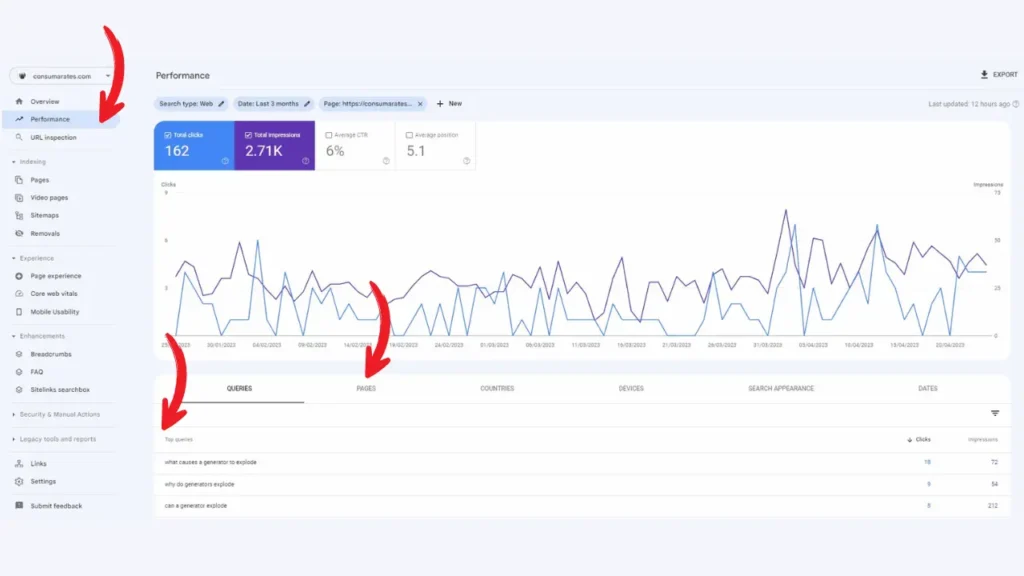
Analyze your content and the queries, and then try to figure out on what terms your website is receiving fewer clicks. Then reoptimize your content accordingly.
SEMrush
SEMRush is one of the best SEO tools available in the market. To perform a content gap analysis using SEMRush, you need to do the following:
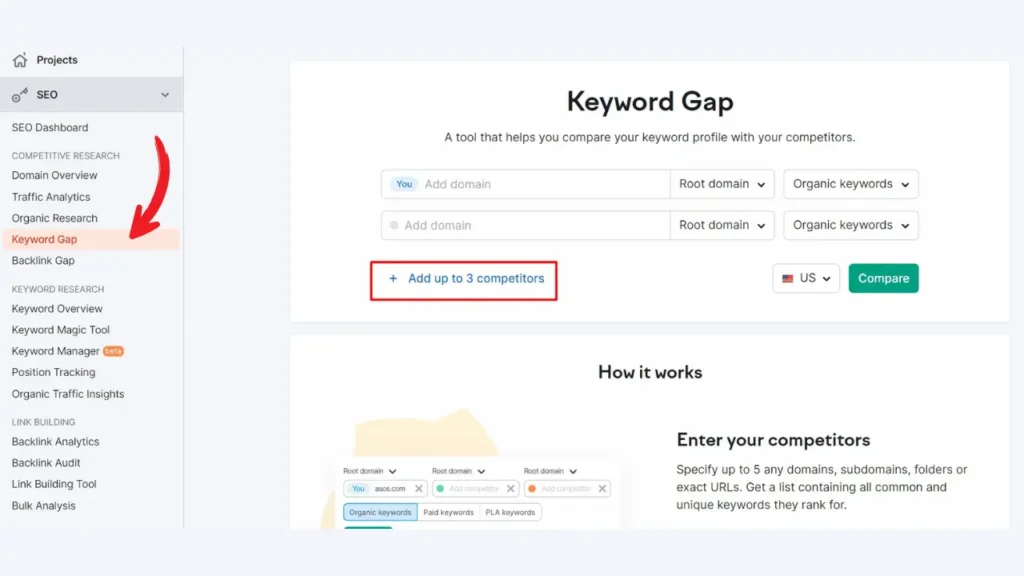
At first login to your SEMRush account and click on ‘Keyword Gap’. Enter your domain and add up to four competitor domains.
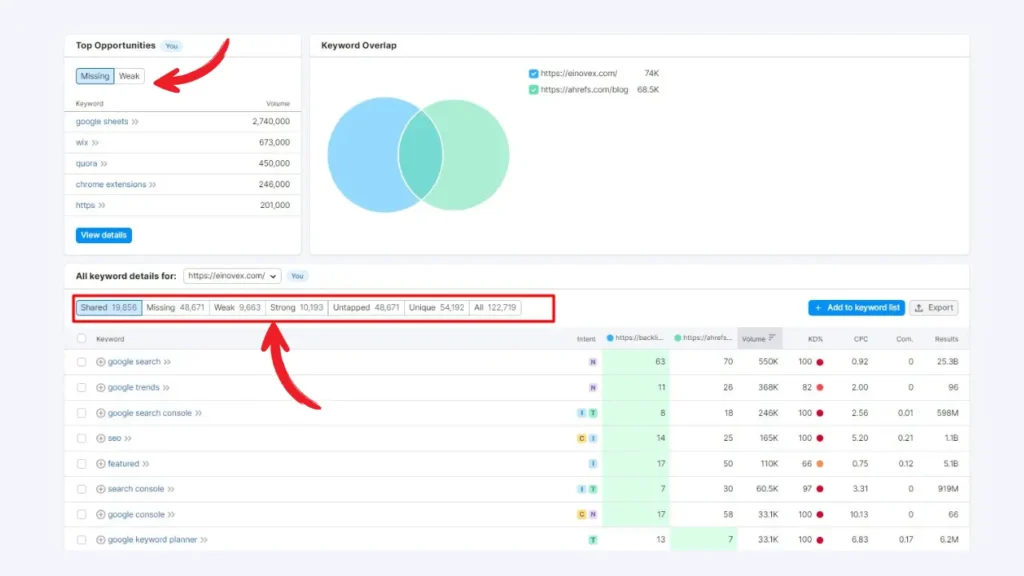
You will then be able to see all the missing keyword opportunities that your competitors are ranking for but you aren’t. Then reoptimize your content accordingly.
CTR optimization
CTR is one of the most important factors used to measure content quality. Here, you can see that the CTR of this page is 6% for ranking on the 5th position.
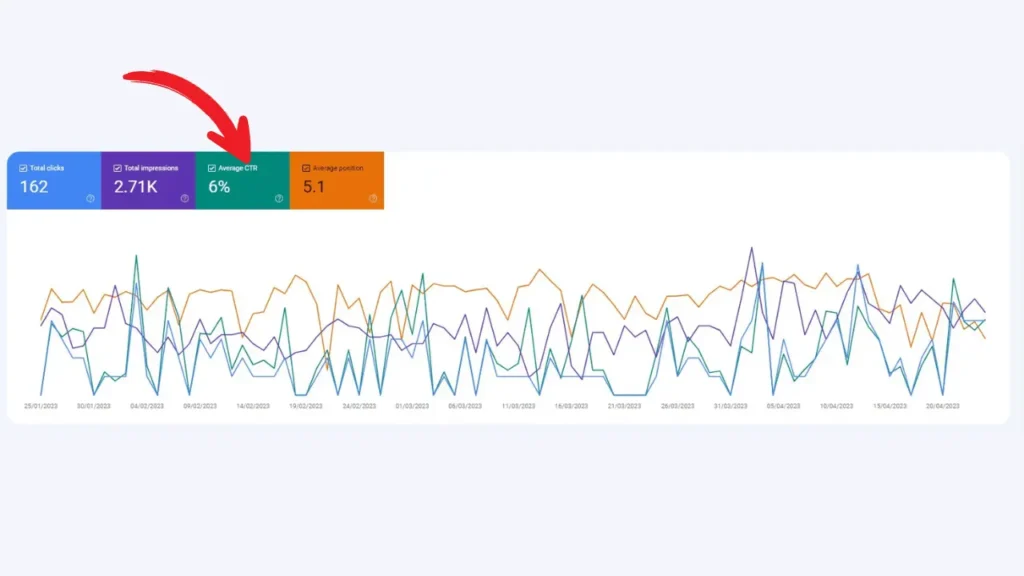
If I can increase my CTR to 7% or more, it will signal to Google that people are really enjoying my content. This will eventually lead to an upward trend in my search engine position.
Improve Page Speed
Page speed is one of the main ranking factors. According to a report from Google, if a page takes more than 3 seconds to load, it can increase the bounce rate up to 90%.
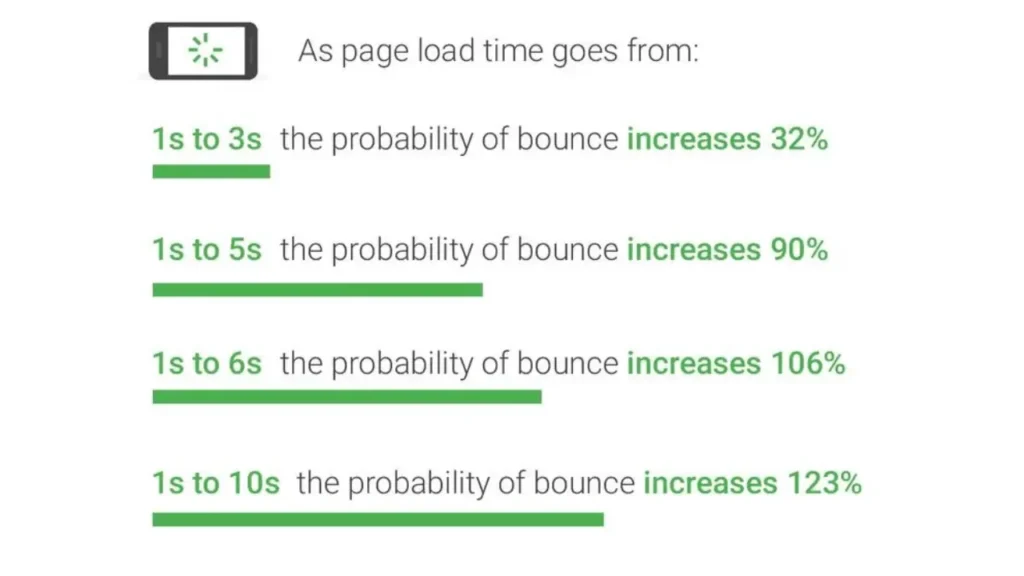
Plugins like WP Rocket (paid) or LiteSpeed Cache (free) can help reduce the total blocking time and decrease loading speed.
Maintain a strong site architecture
Maintaining a strong site architecture is crucial for effective search engine positioning because it enhances user experience, facilitates efficient crawling and indexing by search engines, and strengthens the overall authority of your website.
By implementing a well-structured site architecture, you are setting your website up for success in terms of SEO and user engagement.
Internal linking & anchor text optimization
Internal linking helps search engine crawlers navigate your website more efficiently. By creating a structured hierarchy of content, you make it easier for search engines to understand the relationship between your pages and index them accordingly.
This improved crawlability can lead to higher search engine rankings.
Internal linking helps distribute the value of backlinks throughout your website. By directing traffic from one high-authority page to another, you can evenly distribute the link equity or “link juice,” which can positively impact the search engine positioning of the linked pages.
On the other hand, anchor text optimization allows you to target specific keywords and phrases relevant to your website’s content. By using descriptive and meaningful anchor texts, you give search engines better context about the linked content.
This helps search engines understand the relevance of your pages to specific queries, potentially leading to higher rankings for those keywords.
How do I track and measure search engine positioning?
Tracking and measuring search engine positioning involves monitoring your website’s ranking for specific keywords or phrases in search engine results pages (SERPs) over time. This can help you understand how well your website is performing in search engines and identify areas for improvement.
Tools like SEMRush & Ahrefs help you to monitor it very easily.
What’s Next?
In conclusion, the magical map we call the “Internet” holds countless treasures, but only the most skilled and strategic treasure hunters can unlock their true potential.
To embark on the next step in your search engine positioning journey, begin by analyzing your website’s current performance and identifying areas for improvement.
Optimize your content, build E-E-A-T, and enhance user experience while maintaining a strong site architecture. Engage in continuous learning and stay up-to-date with industry trends to maintain your credibility and authority in your niche.
Remember, search engine positioning is an ongoing process, so stay persistent and patient, consistently refining your strategies to achieve your desired results.



